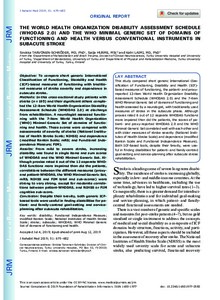The World Health Organization Disability Assessment Schedule (WHODAS 2.0) and the WHO Minimal Generic Set of Domains of Functioning and Health versus Conventional Instruments in subacute stroke
Tarvonen-Schroder S; Hurme S; Laimi K
The World Health Organization Disability Assessment Schedule (WHODAS 2.0) and the WHO Minimal Generic Set of Domains of Functioning and Health versus Conventional Instruments in subacute stroke
Tarvonen-Schroder S
Hurme S
Laimi K
FOUNDATION REHABILITATION INFORMATION
Julkaisun pysyvä osoite on:
https://urn.fi/URN:NBN:fi-fe2021042822992
https://urn.fi/URN:NBN:fi-fe2021042822992
Tiivistelmä
Objective: To compare short generic International Classification of Functioning, Disability and Health (ICF)-based measures of functioning with traditional measures of stroke severity and dependence in subacute stroke.Methods: In this cross-sectional study patients with stroke (n = 195) and their significant others completed the 12-item World Health Organization Disability Assessment Schedule (WHODAS 2.0) at discharge from rehabilitation. A neurologist assessed functioning with the 7-item World Health Organization (WHO) Minimal Generic Set of domains of functioning and health. These scores were compared with assessments of severity of stroke (National Institutes of Health Stroke Scale; NIHSS) and dependence (modified Rankin Scale; mRS; and Functional Independence Measure; FIM).Results: From mild to severe stroke, increasing disability was found in single items and sum scores of WHODAS and the WHO Minimal Generic Set. Although proxies rated 6 out of the 12 separate WHODAS functions more impaired than did the patients, correlations between the different measures (proxy- and patient-WHODAS, the WHO Minimal Generic Set, mRS, NIHSS and FIM total and sub-scores) were strong to very strong, except for moderate correlations between patient-WHODAS, and NIHSS or FIM cognitive sub-score.Conclusion: Despite their brevity, both generic ICF-based tools were useful in finding disabilities for patient- and family-centred goal-setting and service-planning after subacute rehabilitation.
Kokoelmat
- Rinnakkaistallenteet [19207]
